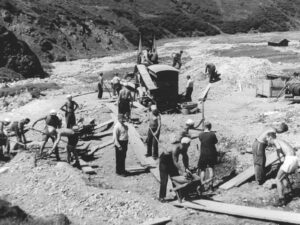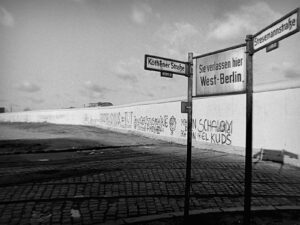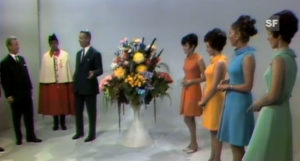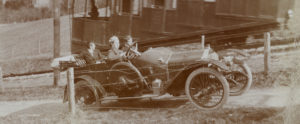
Swiss National Museum
Liquid manure to stop the ‘speeders’
100 years ago, the automobile set out on its triumphant rise to world domination. But the road to the fast lane was bumpy, and sometimes slippery.
Josef Nieth from Bern was the hero on 27 August 1922. In 21 minutes and 43 seconds, the daredevil driver had covered the race route on the Klausen Pass with its 18 sharp left turns, 26 right-hand bends and 84 further hairpin bends, at an average speed of 56.7 kilometres per hour. Vroom!
This journey time was a demonstration of the capabilities of vehicle and driver. It was the best advertisement for this new means of transport, the car – still in its infancy, and controversial as well. The first car race on the Klausen Pass had drawn hordes of spectators along the race route. The Gotthard-Post reported: ‘There was such noise and bustle throughout the night and into the early morning! A single column of automobiles snaked its way up to the Klausen Pass in the dark of night, interspersed with the loud clatter of motorcycles and here and there a groaning pedestrian, who must have felt as if he’d taken his life in his hands.’
1,000 cars lined the route that Sunday, more than any pass in Switzerland had ever seen. Through clouds of dust, 12,000 to 15,000 people cheered on the racing cars as they whizzed by.
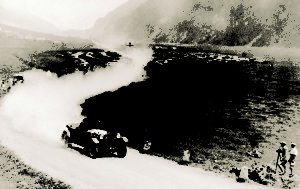
Car race at the Klausen Pass, 1922.
Bernhard Brägger

Leaning into the curve: Racing at the Klausen Pass, 1920s.
Swiss National Museum
Liquid manure and pitchforks to battle motorists
But back then, cars were not a problem-free means of transport. Punctured tyres, boiling coolant water, sputtering engines, broken axles, jammed pistons and knocking connecting rods were the downside of life in the fast lane.
The unpaved roads cast a different kind of shadow over the new vehicles; annoying clouds of dust were created even at low speeds. In addition, cars at that time had poor exhaust systems and made a deafening racket; what’s more, they were faster than people were accustomed to, and therefore dangerous. In the Luzerner Tagblatt one tourist criticised the car as ‘merely a luxury vehicle’ whose only purpose was to ‘give rich people a new sport and… to plague the average person in every respect with dust, bad smells, nervous agitation… To me, an automobile driving through a beautiful, tranquil area is like an ink stain on a wedding dress.’
Before long, assertive types in the countryside were seeing to it that motorists got more than just ink stains. Some were spattered with water or liquid manure, others were stopped by pitchforks or bullwhips, and still others found obstacles such as tree stumps or rocks on the roads – the attitude towards cars was largely negative.
The cantons responded in very different ways: here a ban on Sunday driving, there a blanket driving ban, and elsewhere no restriction, but speed limits of 30 km/h. The free movement of cars was mired in a horrific jumble of rules, charges, permitted driving times and speed limits.
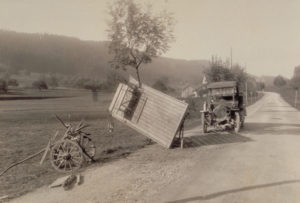
Driving was quite hazardous in the early days. For all road-users. Photo of an accident from the 1920s.
Swiss National Museum

Automobiles on the village square of Andermatt, about 1925.
Staatsarchiv Uri, Altdorf
Money makes the car industry go round
It was mainly thanks to the tourist industry, but also to a growing network of automobile infrastructure with petrol stations, restaurants and garages, that the car finally made its breakthrough. Car enthusiasts were very conscious of the economic importance of the automobile: drivers were seen as tending to be younger, well-to-do, adventurous people with loose purse strings.
That is how the 1922 race on the Klausen Pass came about. The initiative for the contest came from the Zurich section of the Swiss Automobile Club (ACS). Grand Prix races in France and Italy were drawing the crowds, and the people of Zurich wanted to run a mountain race based on the foreign model across the Albis Pass. But the police wouldn’t authorise the event.
So the ACS Zurich switched to the road through the Klausen Pass between Altdorf and Linthal. To get the requisite permits from the Cantons of Uri and Glarus the organisers resorted to some slightly underhand tactics, because car races were in principle prohibited: they mentioned only a ‘mountain test drive’. The Cantonal Council of Uri granted the permit only ‘because this event was unquestionably suitable for boosting tourism, advertising the road through the Klausen Pass, and in addition to increased state revenue generally it would attract not insignificant income into the region.’ Still recovering from the economic crisis of 1921, Uri ended up doing well out of the event: the canton with the driving permits, the hotel industry and restaurants with an influx of visitors. Cars brought in the cash, even in the Alpine cantons.
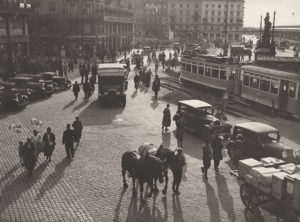
Over time, people got used to the automobile. View of Zurich’s Bahnhofplatz, around 1930.
Swiss National Museum
And so it came about that the government soon proposed standardised rules for driving. The car flicked its indicators for the fast lane. In 1927, however, the brakes were put on temporarily. A first draft law was rejected. It wasn’t until 1933, during the global economic crisis, that standard regulations for automobile traffic finally came into force throughout Switzerland. And, as on the roads of the Klausen Pass a few years earlier, it was fear of the crisis that gave the car the freedom of the open road: Vrooom!

